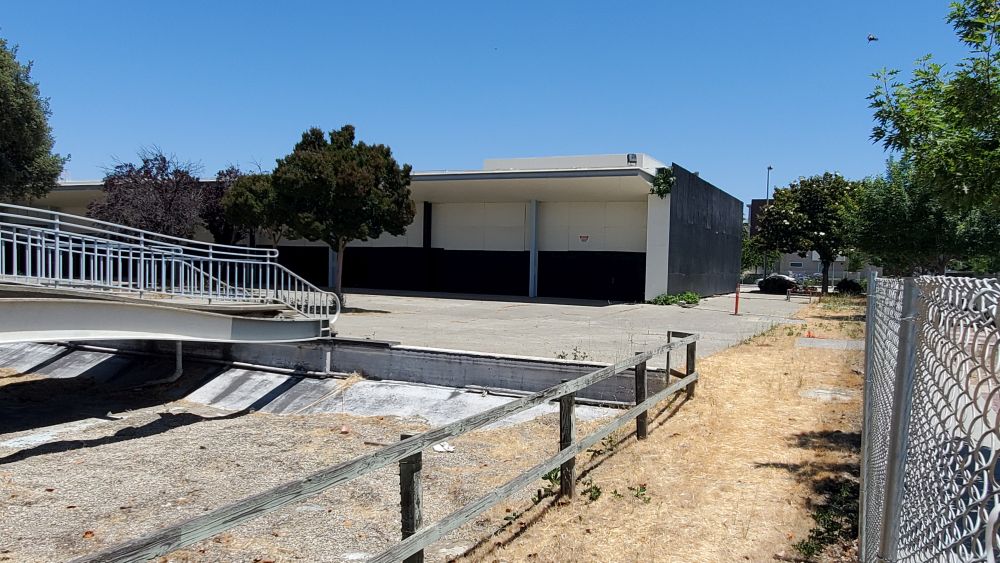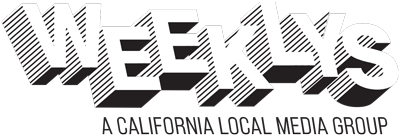My father ate lunch in the same cafeteria that Nikita Khrushchev once visited and now it’s a dump.
One of the most vibrant innovative sites in the entire global history of the computer industry, the old IBM Plant on Cottle Road, no longer exists, but at least one structure still remains.
IBM Building 11, as many still call it, was once a gargantuan cafeteria, eventually serving over 10,000 employees during the plant’s peak. Innovative for its time, the building has been abandoned for years now, but that didn’t stop me from poking around the chain-link fence that surrounds it, especially now since the structure made the PAC*SJ “Endangered 8” list for 2023.
Designed by John Bolles who later designed Candlestick Park in San Francisco, the IBM Cottle Road plant was a sprawling campus of one-story connected buildings, several modern art sculptures, reflecting pools, patio dining and innovative landscaping. In contrast to the dark, enclosed research labs of the day, the IBM was open, airy and a predecessor to today’s sprawling campuses. Various glossy magazines featured the plant because it was a mid-century architectural wonder.
Back then, the term “Silicon Valley” did not yet exist and what’s now the whole southeastern quadrant of San Jose did not either. Orchards and cattle ranches dominated the scene. When the researchers at IBM’s Cottle Road plant worked on pioneering hard drive technology, nobody, especially not the suburban politicians of mid-century San Jose, knew the researchers’ work would transform the valley and the entire world.
Then, in 1959, less than two years after the plant opened, the world’s most popular communist showed up. In a now famous story, Nikita Khrushchev, Premier of the Soviet Union, first visited the US that year. His Bay Area itinerary included the IBM Cottle Road plant because it was a vibrant global epicenter of innovation. According to the State Department’s official record of the journey, Khrushchev “said that had he been in charge of the construction of the IBM plant, he would have built it as a two-story structure because, in his view, this was more efficient and economical.”
Footage of this visit was even included in a PBS documentary. We see Khrushchev arriving at the IBM plant and then in the cafeteria. The USSR did not have self-service cafeterias, so the Premier was quite impressed. He didn’t care about the hard drive technology. He was blown away by the food service.
Accounts of the visit were mentioned in a few books, including Khrushchev’s own memoirs, a book by his son Sergei, and also a book by then IBM president Thomas J. Watson, Jr., the son of IBM’s founder.
In the early ‘60s, my own father even worked at the IBM plant as a programmer. I’m positive he ate in that cafeteria.
Nowadays, not much else of the old IBM plant remains. Fifteen years ago, another historic structure did remain, the iconic Building 25, likewise featured in glossy mid-century magazines, but thanks to San Jose politicians and their real estate buddies, we now have a Lowe’s home improvement monstrosity, plus cultural attractions like Applebee’s and Chipotle.
These events didn’t happen easily, of course. San Jose has a long history of buildings suddenly going up in flames right when a developer wants to do something with the property, and this is exactly what occurred. As usual, the fire was blamed on homeless people. The charred remains of Building 25 were then demolished and the whole neighborhood was developed so suburban nuclear families and tech workers could then hit up Lowe’s to browse for lawnmowers and ceiling fans.
You’re probably way ahead of me on this, but I wish we could bring Khrushchev to the Lowe’s home improvement store. Imagine the scene. He would laugh out loud if he even saw the place, saw how San Jose, the self-proclaimed “Capital of Silicon Valley,” has repeatedly destroyed its own unique identities, over and over again, destroyed its most meaningful historical buildings and landmarks, and then replaced them with the most embarrassing, tasteless aspects of crass American chain-store capitalism, and all just so real estate developers could make a fortune.
After Lowe’s, I’d take Khrushchev to the nearby Applebee’s and the Chipotle. I wonder what he would order.










He should visit my place Chester Chicken he would love my fried chicken using days old grease in Oakland.
Dick Lieberman
[email protected]
I worked at this plant in 1968 and was stationed in a portable until bldg 12 was completed. I was there until 1971 and worked for James Galway and Sam Scribner.
Im not a fan of cookie cutter shopping centers either. But did you want to keep those building as a museum? What do you think they should have done with the buildings?